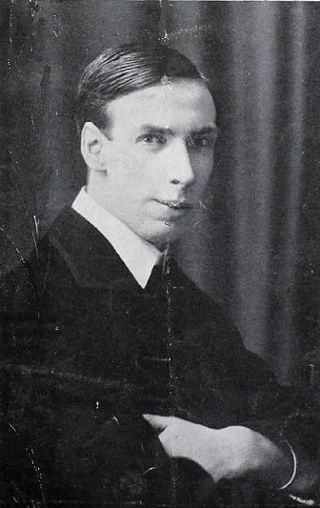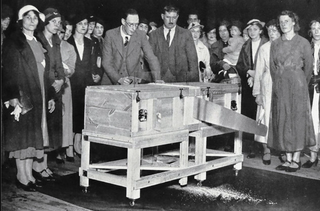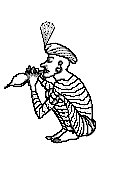
Erik Weisz, known as Harry Houdini, was a Hungarian-American escape artist, illusionist, and stunt performer, noted for his escape acts.

Escapology is the practice of escaping from restraints or other traps. Escapologists escape from handcuffs, straitjackets, cages, coffins, steel boxes, barrels, bags, burning buildings, fish-tanks, and other perils, often in combination.

P. T. Selbit (1881–1938) was an English magician, inventor and writer who is credited with being the first person to perform the illusion of sawing a woman in half. Among magicians he was known for his inventiveness and entrepreneurial instinct and he is credited with creating a long list of successful stage illusions.

Burling Hull was an inventive magician, self-styled "the Edison of magic," specializing in mentalism and sleight of hand effects. During the greater part of his life he lived in DeLand, Florida. His aliases and stage names included: "Volta the Great", "The Man with the Radar Mind", "The White Wizard," and "Gideon ('Gid') Dayn."

Sawing a woman in half is a generic name for a number of stage magic tricks in which a person is apparently cut or divided into two or more pieces.

The bullet catch is a stage magic illusion in which a magician appears to catch a bullet fired directly at them — often in the mouth, sometimes in the hand or sometimes caught with other items such as a dinner plate. The bullet catch may also be referred to as the bullet trick, defying the bullets or occasionally the gun trick.

Christopher Nicholas Sarantakos, known professionally as Criss Angel, is an American magician, illusionist and musician. He is often referred to as one of the world's most successful illusionists, generating in excess of $150 million in tourism revenue for Las Vegas in one year.

Dorothy Dietrich is an American stage magician and escapologist, best known for performing the bullet catch in her mouth and the first woman to perform a straitjacket escape while suspended hundreds of feet in the air from a burning rope. She was the first woman to gain prominence as an escape artist since the days of Houdini, breaking the glass ceiling for women in the field of escapes and magic.

The Chinese Water Torture Cell is a predicament escape made famous by Hungarian-American magician Harry Houdini. The illusion consists of three parts: first, the magician's feet are locked in stocks; next, he is suspended in mid-air from his ankles with a restraint brace; finally, he is lowered into a glass tank overflowing with water and the restraint is locked to the top of the cell.
The table of death is a predicament escape that may be regarded as a magic trick or an act of escapology.

Conjuring is an illustrated book about conjuring, or magic, by James "The Amazing" Randi, who himself was a magician and escape artist. Drawing on his extensive knowledge and experience in the field, Randi offers a series of brief biographies of a variety of noteworthy magicians and their unique styles, including Harry Houdini, Chung Ling Soo, Harry Blackstone Sr., Harry Blackstone Jr., Howard Thurston, and many others. He also provides an overview of several genres of magic such as stage magic, escapology, and mentalism, and of specific tricks such as the bullet catch. Reviews of the book were mainly positive.

A magician's assistant is a performer in a magic act who is not billed as the magician or principal name in the act.

Alan Alan was a British escapologist and magician. He originated tricks that have subsequently become familiar features of the repertoire of other performers and he was honoured by The Magic Circle.

Stage or street magic has a long history in India. Popular tricks include the rope trick, Indian basket, and Indian cups and ball.

The Drill of Death is a large-scale stage illusion in which a performer appears to be impaled on a giant drill. It was created by magician André Kole and illusion designer Ken Whitaker for magician Melinda Saxe. It was one of Saxe's signature tricks and featured as a highlight in her various First Lady of Magic shows.
The World's Most Dangerous Magic was the title of two American television specials showcasing illusion and escapology acts, which were made for the NBC network. The first was originally broadcast on 27 April 1998 and the second, titled The World's Most Dangerous Magic 2, was initially aired on 2 May 1999.
Stage illusions are large-scale magic tricks. As the name implies, stage illusions are distinct from all other types of magic in that they are performed a considerable distance away from the audience, usually on a stage, in order to maintain the illusion. Stage illusions usually use large props and may involve the use of assistants or large animals. Examples of stage illusions include sawing a woman in half and Lady-to-Tiger.

Magic, which encompasses the subgenres of illusion, stage magic, and close-up magic, among others, is a performing art in which audiences are entertained by tricks, effects, or illusions of seemingly impossible feats, using natural means. It is to be distinguished from paranormal magic which are effects claimed to be created through supernatural means. It is one of the oldest performing arts in the world.
Christopher Alfred Goode, better known as Chris Cross, is an English magician, escapologist, and former contortionist. He has performed worldwide and appeared on British television.















